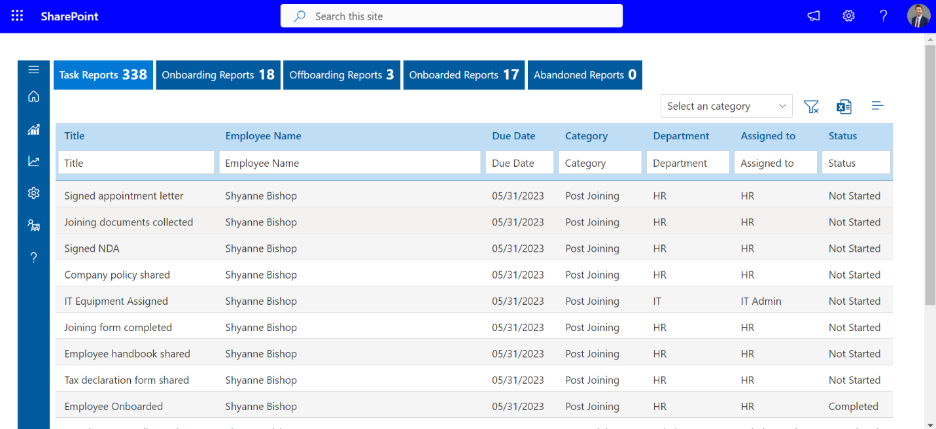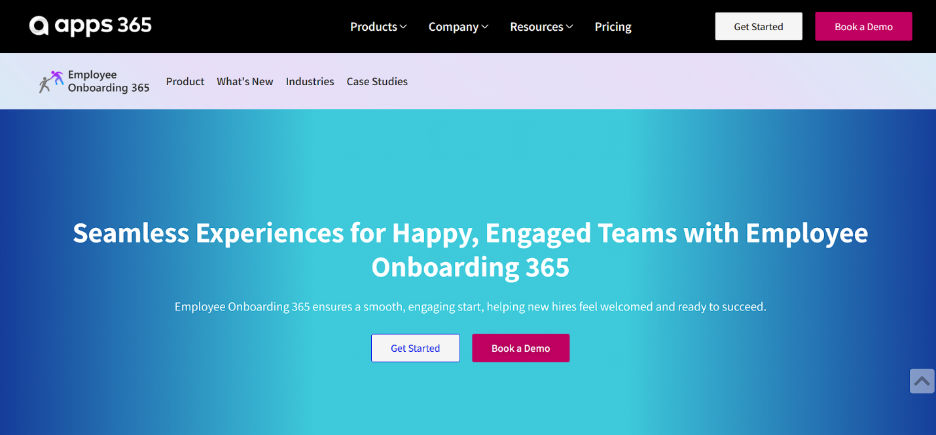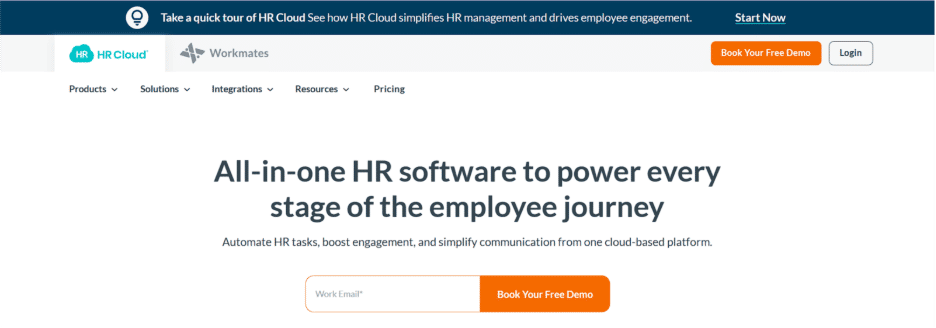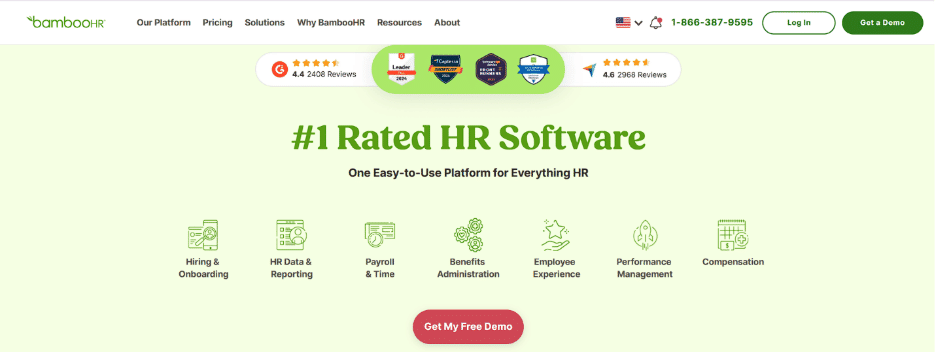
Transform Your Hiring: Best Online Software for Employee Onboarding 2025
Nervous first-day feelings. New hire confusion. Every employee experiences some anxiety when starting a new job, unsure of what to expect or how to navigate their new environment. This uncertainty can lower motivation and slow down productivity in those critical first days.
✨
Quick Read
Summary generated by AI, reviewed for accuracy.
Employee onboarding sets the foundation for engagement, productivity, and retention. Online software for employee onboarding like Employee Onboarding 365 streamlines tasks, automates workflows, and provides real-time tracking for HR and new hires.
With digital forms, self-service portals, and integration with Microsoft 365, companies can reduce errors and improve efficiency. Modern onboarding software transforms traditional, manual processes into a smooth, professional, and engaging experience for every employee.
Imagine if every employee felt confident, valued, and productive from day one. When onboarding is seamless, new hires feel welcomed, understood, and equipped with the tools they need. This positive start builds trust, increases engagement, and encourages long-term loyalty.
The best online software for employee onboarding can make that happen. By automating tasks, providing clear guidance, and centralizing resources, companies can eliminate confusion and delays. It transforms uncertainty into clarity, delay into productivity, and frustration into engagement, setting up both employees and the organization for success.
Why You Need Online Software for Employee Onboarding
High turnover costs are real. Employees who feel unsupported during their first months often leave, costing thousands of companies. Remote and hybrid workforces need clear digital guidance from day one. HR teams are overwhelmed with repetitive paperwork, manual tracking, and missed deadlines.
When new hires get a smooth start, productivity rises, morale improves, and employee retention strengthens. A culture of welcome and confidence is built from the first day.
What “Best” Means in 2025
The best onboarding software in 2025 makes onboarding simple, fast, and secure. It goes beyond digitizing forms to create an engaging and efficient experience. Key features include:
- Ease of Use – Simple, intuitive interface; mobile-friendly for access anywhere.
- Automation – Tasks, reminders, and follow-ups happen automatically, saving HR time.
- Self-Service – New hires can complete forms, track progress, and access training independently.
- Analytics – Dashboards show progress, highlight challenges, and guide improvements.
- Security & Compliance – Protects sensitive data and maintains audit-ready records.
Benefits of Online Onboarding Software
Faster Productivity
New employees can complete pre-boarding tasks, mandatory training, and paperwork even before their first day. This early preparation allows them to start contributing to projects sooner and reduces downtime. Studies show that companies using automated onboarding can cut ramp-up time by 30–50%, giving both employees and teams a faster start.
Enhanced Employee Experience
Clear communication, structured task onboarding checklists, and engagement tools make new hires feel welcomed, valued, and connected from day one. When employees know exactly what to do and where to find resources, their confidence and satisfaction increase.
According to STRONGDM, Research indicates that 29% of new hires feel unprepared after traditional onboarding methods, highlighting the need for a modern approach.
Error Reduction
Manual processes often result in lost forms, missing signatures, or incomplete documentation. Online onboarding software automates these tasks, ensuring accuracy and reducing mistakes. This not only saves time but also minimizes frustration for both HR teams and new employees.
Compliance and Security
Data protection is a critical part of onboarding. Digital forms, encrypted storage, and audit-ready e-signatures ensure sensitive information is securely managed. Automated tracking also helps companies comply with labor laws, GDPR, and other regulatory requirements, reducing risk and protecting the organization.

Insights and Analytics
Modern onboarding software provides dashboards and reports that give HR real-time insights into the onboarding process. These analytics highlight where new hires struggle, which tasks take longer than expected, and where improvements are needed. With this information, HR teams can continuously refine workflows, improve engagement, and create a smoother experience for every employee.
Features of the Best Online Software for Employee Onboarding
| Feature | Why It Matters |
| Automated workflows | Ensure consistency, prevents missed steps, and saves HR time by automating repetitive tasks. |
| User-friendly interface | Easy for both new hires and HR staff; short learning curve ensures smooth adoption. |
| Digital forms & e-signatures | Complete paperwork securely and legally before day one, reducing manual errors. |
| Self-service portal | Employees can track tasks, training, and onboarding progress anytime, improving engagement. |
| Security & compliance tools | Protects sensitive employee data and ensures audit readiness to meet regulatory requirements. |
| Analytics dashboards | Identify challenges, monitor completion rates, and improve processes through data insights. |
| Engagement tools | Welcome messages, team introductions, and feedback surveys help new hires feel included. |
| Mobile access | Complete onboarding on phones or tablets, ideal for remote or hybrid teams. |
| Customizable training modules | Tailor onboarding programs to different roles or departments for more effective learning. |
| Integration with productivity tools | Seamlessly connects with apps like Microsoft 365, Teams, or Slack for smoother workflows. |
Common Pitfalls Without Online Onboarding Softwareg
Without a proper onboarding system, companies can face many challenges:
- Lost documents – Paper forms and contracts can get misplaced, causing delays and errors. This can also lead to compliance issues and wasted HR time.
- Delayed start dates – Accounts, training, and equipment may not be ready on time. As a result, new hires spend their first days waiting instead of contributing.
- Confused new hires – Incomplete instructions and inconsistent guidance leave employees frustrated. This confusion can reduce engagement and affect long-term retention.
- Strained HR teams – Manually tracking tasks and sending reminders creates extra workload and stress. HR resources are diverted from strategic initiatives to routine follow-ups.
- Limited visibility – Without dashboards, it’s hard to see progress or identify challenges. Managers struggle to measure onboarding success and make improvements.
Using online onboarding software solves these problems, making the process smooth, efficient, and stress-free for both employees and HR.
How to Choose the Right Platform
Selecting the right onboarding software is crucial to ensure a smooth, effective process for new hires. Here’s a simple guide to help you choose:
- Identify Your Hiring Needs
Determine whether your employees are remote, on-site, or hybrid. Consider the number of hires and the complexity of your onboarding process to choose a platform that fits your company’s size and workflow. - Prioritize Key Features
Focus on the features that solve your biggest pain points, such as automation, self-service portals, analytics, or engagement tools. Make sure the software aligns with your company’s goals. - Test Usability
Try the platform with a small group of HR staff and new hires. Ensure the interface is intuitive, and tasks are easy to complete. A complicated system can slow down adoption and reduce effectiveness. - Check Integrations
Confirm the software works well with existing onboarding tools, especially productivity suites like Microsoft 365, Teams, or Slack. Smooth integration reduces manual work and keeps all workflows connected. - Verify Security and Compliance
Make sure the platform protects sensitive employee data and meets regulatory standards. Look for encryption, audit-ready records, and certifications to reduce risk. - Evaluate Support and Training
Good vendors provide onboarding, training, and responsive customer support. This ensures your HR team can troubleshoot quickly and get the most out of the software.
Choosing the right platform ensures a faster, more organized, and stress-free onboarding experience for both new hires and HR teams?.
Difference Between Traditional and Online Onboarding
| Aspect | Traditional Onboarding | Online Onboarding |
| Paperwork | Manual, error-prone | Digital, automated, secure |
| Time to Productivity | Weeks of delays | Tasks completed before day one |
| Employee Experience | Confusing, slow | Clear, engaging, and supportive |
| HR Workload | High | Reduced with automation |
| Visibility | Limited | Real-time dashboards |
| Engagement | Minimal | Welcome messages, team intros, surveys |
| Compliance | Risk of missing records | Fully trackable and audit-ready |
| Consistency | Onboarding varies between departments | Standardized process across all teams |
| Tracking Progress | Difficult to monitor new hire completion | Easy monitoring of task completion and milestones |
| Feedback & Improvement | Rarely collected or used | Continuous feedback helps improve the process |
Top 5 Best Onboarding Software in 2025
1. Employee Onboarding 365

Our flagship platform is designed to lead the market in online employee onboarding. It integrates seamlessly with Microsoft 365, allowing HR teams and managers to manage the entire onboarding process efficiently through familiar tools like Teams, Outlook, and SharePoint it help to onboard employee.
Digital forms & checklists – Employees can complete all necessary paperwork securely before their first day, eliminating delays and errors.
- Task automation – Automated workflows and reminders ensure that nothing is missed, reducing manual HR effort.
- Engagement tools – Personalized welcome messages, team introductions, and mentor assignments help new hires feel valued and connected.
- Analytics dashboard – Real-time insights allow HR to track progress, spot challenges, and measure onboarding success.
- Focused onboarding efficiency – Unlike other platforms, Employee Onboarding 365 avoids unnecessary payroll or HRIS features, keeping the process simple and highly effective.
2. HR Cloud

HR Cloud is a scalable onboarding platform suitable for companies of all sizes. Its features focus on structured journeys and enhanced engagement.
- Guided onboarding journeys – Step-by-step workflows for every department or role make it easy for new hires to follow.
- Customizable dashboards – Managers can monitor task completion and track onboarding performance across teams.
- Document management – Centralized and secure storage for all employment contracts, forms, and compliance documents.
- Engagement tools – Built-in surveys, introductions, and messaging help build a strong first impression and improve retention.
3. BambooHR

BambooHR is ideal for medium and growing companies that prioritize employee experience and engagement.
- Digital forms & e-signatures – Paperless onboarding makes it faster and more secure for employees to complete documentation.
- Task reminders – Automatic notifications and alerts ensure employees stay on track with onboarding tasks.
- Welcome communications – Personalized emails and introductions to teams help new hires feel part of the company immediately.
- Integration options – Connects seamlessly with other HR tools to streamline workflows and reduce manual work.
4. Prepio

Prepio is a modern onboarding platform designed to accelerate the hiring process with onboard automation and role-specific customization.
- Automated workflows – Simplifies repetitive HR tasks, reducing errors and saving time.
- Role-based checklists – Tailored onboarding programs ensure employees get the right training and resources for their position.
- Progress tracking – Managers can monitor completion and identify where new hires may need additional support.
- Mobile-friendly access – Employees can complete onboarding tasks anywhere, using smartphones or tablets, perfect for remote teams.
5. Zoho People

Zoho People is a cost-effective, user-friendly onboarding platform suited for small to mid-sized businesses.
- Task automation – Reminders, approvals, and notifications ensure onboarding processes stay on schedule.
- Document management – Employees can upload and sign contracts, agreements, and forms digitally.
- Customizable onboarding templates – Standardize processes across teams and departments to ensure consistency.
- Employee self-service portal – New hires can access training materials, complete tasks, and track progress independently, reducing HR intervention.
How Employee Onboarding 365 Will Help Our Company
Employee Onboarding 365 is more than just software, it’s a complete onboarding solution that transforms the way our company welcomes, trains, and integrates new hires. By using this platform, we can streamline processes, improve engagement, and ensure every employee starts off successfully.
Streamlined process
- Automates repetitive HR tasks, reducing manual work and human error.
- Prepares forms, accounts, and training assignments automatically.
- Frees HR staff to focus on strategic planning and employee development.
- Standardizes onboarding across departments for consistency and efficiency.
Faster employee productivity
- Ensures new hires are ready to contribute from day one.
- Documentation, training, and system access are completed before the first day.
- Reduces downtime and accelerates integration into teams and projects.
- Helps employees quickly understand roles, responsibilities, and expectations.
Enhanced employee engagement
- Makes new hires feel valued, welcomed, and confident.
- Structured welcome activities and team introductions create a sense of belonging.
- Mentorship assignments and interactive training keep employees motivated.
- Feedback surveys help employees feel heard and supported from the start.
Better visibility and tracking
- Gives managers and HR real-time insights into onboarding progress.
- Dashboards show completed tasks, pending items, and Challenge.
- Early identification of issues allows managers to intervene and support employees.
- Data-driven insights enable continuous improvement of onboarding processes.
Security and compliance assurance
- Protect sensitive employee information and ensure regulatory compliance.
- All digital forms and records are securely stored with encryption.
- Audit-ready reports reduce compliance risks and simplify inspections.
- Ensures that all onboarding tasks are documented and verifiable for legal purposes.
By implementing Employee Onboarding 365, our company can:
- Reduce errors and avoid missing tasks.
- Improve employee retention through a positive, structured onboarding experience.
- Ensure every new hire feels supported, confident, and ready to contribute effectively.
This solution turns onboarding from a manual, error-prone process into a smooth, professional, and engaging experience for both employees and HR teams.
Enhancing Employee Engagement from Day One
Employee engagement starts before the first day and continues throughout the onboarding journey. When new hires feel welcomed, valued, and supported, they adapt faster, build stronger relationships, and become more productive. Employee Onboarding ensures engagement is prioritized from the very beginning:
- Structured Welcome Activities – Personalized welcome messages and team introductions help new employees feel immediately part of the company culture. These activities reduce anxiety, increase confidence, and foster a sense of belonging.
- Mentorship Programs – Assigning mentors gives new hires a go-to person for questions, guidance, and encouragement. Mentorship accelerates learning, creates stronger bonds within teams, and improves retention.
- Interactive Training Modules – Role-specific, interactive training keeps employees engaged and motivated. Gamified elements, quizzes, and step-by-step tutorials enhance learning and ensure employees understand their responsibilities thoroughly.
- Feedback Opportunities – Early surveys and feedback forms allow new hires to express concerns, ask questions, and share their experiences. This makes employees feel heard, valued, and invested in the company’s success.
By implementing these engagement strategies, Onboarding ensures that every new hire feels supported, motivated, and ready to contribute effectively from day one, creating a culture of trust and productivity.
Real-Time Tracking and Analytics for HR
Monitoring onboarding progress in real-time allows HR teams to identify issues early, improve processes, and ensure that new hires complete their tasks efficiently. With Employee Onboarding , managers gain actionable insights to optimize every stage of onboarding:
- Dashboard Visibility – HR can instantly see which tasks have been completed, which are pending, and where delays are occurring. This eliminates confusion, reduces follow-ups, and keeps the onboarding process on track.
- Challenge Identification – Analytics highlights new hires facing difficulties, whether it’s completing documentation, accessing training, or understanding workflows. Managers can provide targeted support to resolve issues quickly.
- Performance Insights – Detailed reports show completion rates, engagement levels, and training effectiveness. These insights help HR assess the efficiency of the onboarding program and measure its impact on employee productivity.
- Continuous Improvement – By analyzing trends and patterns, HR can refine workflows, update training materials, and enhance engagement strategies. Continuous feedback loops create a dynamic onboarding process that evolves to meet the needs of employees and the organization.
Real-time tracking and analytics transform onboarding from a reactive, manual process into a proactive, data-driven system. HR can act swiftly, ensure compliance, reduce errors, and provide a consistent, smooth, and professional experience for every new hire.
Conclusion
Transform your onboarding process with Employee Onboarding 365 and give your new hires a seamless, engaging, and productive start from day one. Automate tasks, track progress in real-time, and ensure every employee feels welcomed and confident. Don’t wait book a demo now to see how our platform can streamline your onboarding and boost employee productivity.
Join Our Creative Community
Frequently Asked Questions
What is online software for employee onboarding, and how does it work?
Online software for employee onboarding is a digital platform that automates the process of welcoming, training, and integrating new hires. It allows HR teams to manage tasks, collect documents, and track progress all in one place. With online software for employee onboarding, companies can save time, reduce paperwork, and provide a more engaging experience for new employees.
Which is the best online software for employee onboarding in 2025?
The best online software for employee onboarding in 2025 offers automation, real-time tracking, and strong data security. Tools like Employee Onboarding 365, HR Cloud, and BambooHR streamline every step from document submission to training completion ensuring new hires are productive and engaged from day one.
How can employee onboarding software for small businesses improve efficiency?
Employee onboarding software for small business helps simplify and automate HR tasks that would otherwise take hours of manual work. It enables smaller teams to manage onboard checklists, e-signatures, and training in a single dashboard, saving time and reducing errors while ensuring every new hire feels supported.
What makes an employee onboarding platform essential for remote and hybrid teams?
An employee onboarding platform provides centralized access to onboarding materials, training modules, and progress tracking all accessible from anywhere. This ensures that remote and hybrid employees experience a consistent and structured onboarding process, improving engagement and productivity from day one.
Why should companies invest in the best employee onboarding software?
Investing in the best employee onboarding software ensures that every new hire gets a seamless and professional start. It reduces administrative workload, automate documentation, and improves compliance tracking. Most importantly, it enhances employee satisfaction and retention by creating a positive first impression.


_mVFFaHUZhS.webp)


_JiluXJRGNl.svg)



















